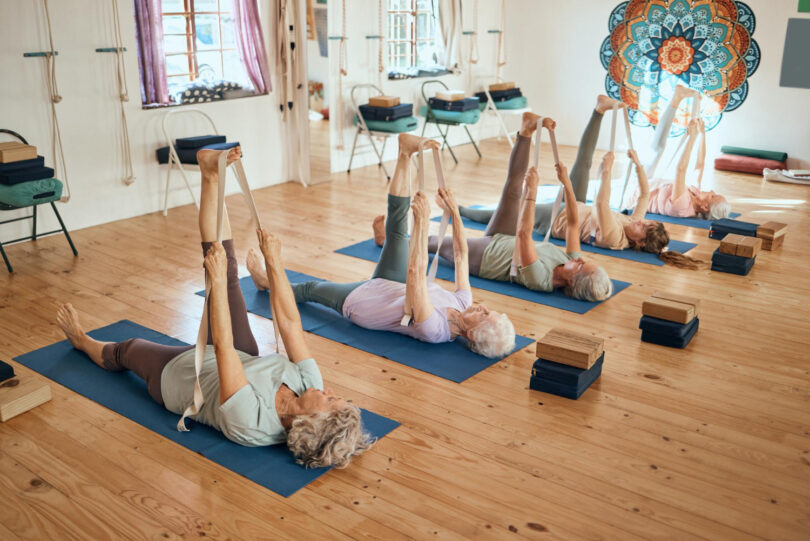# Introduction to
Yoga, an ancient practice with roots stretching back thousands of years in India, has evolved into a global phenomenon appreciated for its physical, mental, and spiritual benefits. Today, it’s adopted by millions who seek a peaceful oasis in their busy lives.
## Benefits of Yoga
Regular yoga offers significant benefits, including improved flexibility, strength, balance, and mental health. Discover more about the benefits of yoga to gain a deeper understanding of how it can enhance your life.
## Popularity of Yoga
The growing awareness of wellness and self-care has led to a surge in the popularity of yoga, making it a staple in fitness regimes worldwide.
##How to Choose a Yoga Studio
Selecting the proper yoga studio is crucial. Consider the types of yoga offered, the qualifications of instructors, and the studio environment. To start, learn how to create a yoga practice that resonates with your goals.
# Finding Yoga Studios Near You
To find yoga studios near you, you can use several methods depending on your preferences and the resources available:
- Google Maps: Type “yoga studios near me” in the Google Maps search bar. This will show you a list of nearby yoga studios, ratings, reviews, and sometimes class schedules.
- Yoga Apps: Apps like Mindbody or ClassPass allow you to search for yoga classes and studios based on location. These apps often offer the added benefit of seeing class schedules and booking directly through the app.
- Social Media: Platforms like Facebook and Instagram can be helpful in finding local businesses, including yoga studios. You can use location tags or search by hashtags such as #yoganearme or #yogastudio<yourcity>.
- Local Fitness Websites and Blogs: These often list yoga studios and might provide reviews and recommendations. Local fitness enthusiasts may also share their experiences and offer insights into the best studios around.
- Word of Mouth: Asking friends, family, or coworkers for recommendations can lead you to great local spots that might not be as prominent online.
## Types of Yoga Offered
There are many types of yoga, each offering different benefits and experiences. Here’s an overview of some popular styles:
- Hatha Yoga: This is a general category that includes most yoga styles. It is an old system that includes the practice of asanas (yoga postures) and pranayama (breathing exercises), which help bring peace to the mind and body.
- Vinyasa Yoga: Often called flow yoga, Vinyasa involves a series of poses that will move you through the power of inhaling and exhaling. Vinyasa movements are smoothly flowing and almost dance-like, which explains why it is sometimes referred to as Vinyasa Flow or just Flow.
- Ashtanga Yoga: This style is rigorous and follows a specific sequence of postures. It is similar to Vinyasa yoga as it combines movement and breath.
- Iyengar Yoga: Known for using props like belts, blocks, and blankets, Iyengar focuses on alignment and precise movements. It’s excellent for beginners and advanced yogis who want to perfect their forms.
- Bikram Yoga: This type of yoga consists of 26 poses and two breathing exercises. It is practiced in a room heated to approximately 105 degrees Fahrenheit with 40 percent humidity, and it’s also known as hot yoga.
- Kundalini Yoga: This form is centered on awakening kundalini energy through meditation, pranayama, chanting mantra, and yoga asana. It’s said to help build physical vitality and increase consciousness.
- Yin Yoga: A meditative approach to yoga, Yin focuses on lengthening connective tissues and complements yang yoga. Yin poses are held for extended periods of time.
- Restorative Yoga: This type of yoga involves practicing very gentle poses for long periods while using props like yoga bolsters, pillows, and blankets to help you relax and rest.
- Power Yoga is an active and athletic form adapted from the traditional Ashtanga system in the late 1980s to appeal to aerobic-crazed Westerners. It moves quickly through the poses, and each is held for only three to five breaths.
- Anusara Yoga is a relatively new form of yoga (1997) that pairs strict principles of alignment with a playful spirit. Postures can be challenging, but the real message of Anusara is to open your heart and strive to connect with the divine in yourself and others.
# Top Yoga Studios in Major Cities
Listing the top yoga studios in major cities worldwide can be quite extensive due to the popularity and variety of studios available. Here’s a general guide to some well-regarded yoga studios in a few key cities globally:
- New York City:
- Yoga to the People: Known for its donation-based classes, this studio is famous for making yoga accessible to everyone.
- Pure Yoga: A premium yoga studio with a wide range of classes and highly trained instructors.
- NYC’s vibrant yoga scene includes studios like “Yoga to the People” and “Pure Yoga.” Exploring yoga classes in New York can be a thrilling experience for New Yorkers or visitors.
- Los Angeles:
- YogaWorks: Famous for its high-quality instructors and multiple locations across the city.
- Modo Yoga: Known for its commitment to eco-consciousness and hot yoga classes.
- In LA, studios like “YogaWorks” and “Modo Yoga” are popular among celebrities and yoga enthusiasts. These studios often incorporate elements of Californian yoga trends.
- London:
- Triyoga: Offers a variety of yoga styles with top-notch teachers in beautifully designed spaces.
- The Life Centre: A staple in the London yoga community, known for its welcoming atmosphere and variety of yoga disciplines.
- Sydney:
- BodyMindLife: Highly popular among locals, offering classes in yoga and Pilates with a holistic approach.
- Power Living: Known for its modern take on yoga and strong community vibe.
- Toronto:
- Downward Dog Yoga Centre: One of the first yoga studios in Toronto, known for its Vinyasa Yoga.
- Moksha Yoga: A well-loved chain across Canada, known for its hot yoga classes.
- Paris:
- Rasa Yoga Rive Gauche: Offers classes in a range of styles in a beautiful, tranquil space.
- Yoga Village: Located near the Opera, this studio is known for its dynamic classes and experienced teachers.
- Tokyo:
- Sun and Moon Yoga: Offers classes in English, which is a plus for expatriates and travelers.
- YogaJaya: Renowned for its comprehensive approach to yoga and high-quality instruction.
- Berlin:
- Yoga Sky: A spacious studio offering a variety of yoga styles, known for its community feel.
- Spirit Yoga: Known for its rigorous style and professional approach to yoga teaching.
- Bangalore:
- a1000yoga: An established studio known for its trained instructors and therapeutic approach.
- Total Yoga: A trendy yoga studio that focuses on a holistic approach to yoga practices.
These studios are celebrated for their quality, community, and diversity of yoga practices. If you’re traveling or new to any of these cities, they could be great places to start your yoga journey.
# Benefits of Joining a Local Yoga Studio
Joining a local yoga studio can offer a variety of benefits that go beyond just physical fitness. Here are some key advantages:
- Structured Learning Environment: Yoga studios provide a structured environment to learn and practice yoga with the guidance of experienced instructors. This helps in building a solid foundation in yoga techniques and forms, ensuring that the practice is done safely and effectively.
- Community and Social Interaction: Attending classes at a local yoga studio can help you connect with like-minded individuals who share similar health and wellness goals. This sense of community can be very supportive and motivating.
- Variety of Classes: Most yoga studios offer a range of classes that cater to different levels of experience and interests, from beginners to advanced practitioners. This variety allows you to explore different styles of yoga within the same environment.
- Consistency and Routine: Joining a yoga studio can help establish a consistent routine, which is often a key component in achieving long-term fitness and wellness goals. Regular classes encourage you to carve out time for your practice in your schedule.
- Access to Professional Guidance: Instructors in yoga studios are typically well-trained and can provide immediate feedback and adjustments. This personalized attention ensures that you develop your yoga practice correctly and can help prevent injuries.
- Enhanced Focus and Dedication: The dedicated space of a yoga studio is designed to minimize distractions and create an environment where you can focus entirely on your practice. This can enhance both your physical practice and your mental meditation.
- Wellness Workshops and Special Events: Many yoga studios host workshops, guest lectures, and special events that provide deeper insights into yoga and related health and wellness topics. These can enrich your understanding and practice of yoga.
- Stress Relief and Mental Health: Regular yoga practice is known for its stress-relieving benefits. Practicing in a studio setting, often with calming decor and a peaceful ambiance, can enhance these benefits and contribute to better mental health.
- Physical Health Benefits: Beyond flexibility and balance, yoga helps improve strength, endurance, and bodily alignment. These benefits are maximized under the supervision of professional instructors who can tailor practices to your physical condition and goals.
- Motivation and Accountability: Being part of a yoga community and having instructors who know you and your fitness goals can significantly increase your motivation and accountability. It’s easier to keep up with regular practice when others encourage your progress.
# What to Expect in Your First Yoga Class
Attending your first yoga class can be an exciting but nervous experience, especially if you’re unsure of what to expect. Here’s a guide to help you feel more prepared and comfortable:
- Arrival and Setup: Try to arrive at least 10-15 minutes early. This gives you time to check in, change your yoga attire, and set up your mat in the studio. If unsure where to place your mat, observe others or ask the instructor.
- Introduction to the Instructor: It’s a good idea to introduce yourself to the instructor before the class starts. Let them know it’s your first class, and inform them of any injuries or health issues you have. This will help them provide modifications and ensure your safety.
- Essential Equipment: Most studios provide yoga mats, but you can bring your own. It’s also common to use props like blocks, straps, and bolsters to help with poses. If you’re unsure how to use these, don’t hesitate to ask the instructor for help.
- Warm-Up: Classes usually start with a warm-up to gently prepare your body for more intense poses. This might include breathing exercises, gentle stretching, or basic postures.
- Main Session: The core of the class can vary greatly depending on the type of yoga being taught. In general, expect a sequence of poses that may challenge your balance, strength, and flexibility. The instructor will demonstrate poses and provide verbal cues. Follow along at your own pace and take breaks if you need them.
- Breathing: Yoga places a significant emphasis on breathing techniques, which are integral to the practice. The instructor will guide you on when to breathe in or out during poses, which helps in maintaining balance and focus.
- Modifications: If a pose feels uncomfortable, the instructor can offer modifications to make it easier. Don’t feel pressured to match what others are doing; yoga is very much a personal practice.
- Cool Down and Savasana: Towards the end of the class, the pace will slow down with stretches and perhaps a final relaxation pose called Savasana, where you lie flat on your back and relax deeply for a few minutes.
- Closing the Class: The instructor will typically end the class with a greeting or gesture, often saying “Namaste” (meaning “the divine in me bows to the divine in you”). The class responds in kind, marking the end of the session.
- Hydration and Rest: After class, drink plenty of water and give yourself a moment to enjoy yoga’s mental clarity and calm. It’s normal to feel a mix of exhaustion and energy.
Remember, yoga is a practice where growth happens over time. Each class can feel different, and your body might respond in unexpected ways. Enjoy the journey and listen to your body, adjusting your practice to suit your needs.
## Personal Stories
People’s experiences with yoga studios often carry personal stories of transformation, community, and discovery. Here are a few such stories:
- Finding Community:
- Emily’s Story: After moving to a new city, Emily felt isolated and struggled to make friends. She joined a local yoga studio on a whim, seeking merely to stay active. But what she found was much more valuable—community. The studio hosted regular social events, and she quickly became part of a tight-knit group. The yoga studio became a crucial support network for Emily, helping her settle into her new life.
- Physical and Mental Transformation:
- Mark’s Journey: Mark started attending yoga to alleviate severe back pain, which his physical therapist recommended as a gentle way to strengthen his core and improve flexibility. Over time, not only did his back pain lessen, but he also found that yoga sessions helped him manage stress and anxiety. The discipline and focus required in each class taught him mindfulness techniques that he applied daily, leading to significant mental health improvements.
- A Place for Healing:
- Linda’s Sanctuary: After a difficult period of loss and grief, Linda turned to yoga as a way to cope with her emotional turmoil. The yoga studio became her sanctuary, where she could feel her feelings without judgment. The empathetic guidance of her instructors and the restorative practices helped her process her grief at her own pace, fostering healing both on and off the mat.
- Discovering Inner Strength:
- Alex’s Revelation: initially skeptical about yoga, Alex attended his first class expecting little more than a good stretch. Instead, he discovered a challenging physical practice that tested his limits and a philosophical approach that challenged his ways of thinking. Yoga became a tool for personal growth, revealing an inner strength he hadn’t recognized before and inspiring him to take on challenges beyond the mat.
- A Journey of Self-Discovery:
- Sarah’s Exploration: Sarah used yoga to connect with her inner self and spiritual path. Each class explored deeper self-awareness and the practice of living intentionally. Through various styles of yoga taught at her studio, she explored aspects of her personality in a supportive, nurturing environment, enhancing her self-esteem and understanding of her body.
# Online vs. In-Person Yoga Classes
Both online and in-person yoga classes offer unique benefits, and choosing between them can depend on personal preferences, lifestyle, and goals. Here’s a comparison to help you decide which might be right for you:
In-Person Yoga Classes
Pros:
- Hands-On Instruction: In-person classes provide direct feedback and adjustments from instructors, which can be crucial for mastering poses and preventing injury.
- Community Interaction: Attending a local studio allows you to meet and interact with like-minded individuals, fostering a sense of community and belonging.
- Structured Environment: The dedicated space and set class times help establish a routine and minimize distractions, making it easier to focus and stay committed.
- Motivation: Being physically present in a class with others can increase motivation and accountability, pushing you to attend regularly and engage fully during sessions.
Cons:
- Cost: In-person classes are more expensive than online offerings, especially if you are considering unlimited memberships or attending multiple weekly classes.
- Travel Time: Getting to and from a yoga studio can add extra time to your day, which can be a significant drawback for those with busy schedules or limited transportation options.
- Fixed Schedules: The studio sets Class times, which might not always align with your schedule, potentially limiting your ability to attend.
Online Yoga Classes
Pros:
- Flexibility: Online classes can be accessed anytime and anywhere, offering flexibility that fits yoga into any schedule, regardless of your daily commitments.
- Variety: You can access a wide range of instructors, styles, and class lengths online, more than what might be available at your local studio.
- Cost-Effectiveness: Many online platforms offer affordable subscriptions or even free classes, which can be more economical than studio memberships.
- Comfort of Home: Practicing at home means you can create a personalized space and practice in comfort without feeling self-conscious, especially if you are a beginner.
Cons:
- Lack of Personalized Guidance: Without a teacher present, getting the form right or receiving modifications based on your unique needs can be challenging, increasing the risk of injuries.
- Reduced Community Feeling: Although some online platforms offer community forums or live classes, the sense of community is generally less tangible than what you’d find in a physical studio.
- Self-Motivation Required: Without the structure of a physical class and other participants, it may be harder to maintain motivation and discipline in a home setting.
Ultimately, the choice between online and in-person yoga classes comes down to what you value most in your practice. If personal interaction and structured environments are essential to you, in-person classes are likely a better fit. However, if you prioritize flexibility and variety, online classes might meet your needs more effectively. Many people find a hybrid approach—combining both online and in-person classes—works best to balance the benefits of each.
FAQs
How Profitable Are Yoga Studios?
The profitability of yoga studios can vary significantly based on location, the size of the client base, pricing structures, and operational costs. Generally, successful yoga studios in well-populated areas with a solid customer base can be profitable. However, rent, instructor salaries, marketing expenses, and competition also influence profitability. Smaller studios or those in saturated markets might find it challenging to achieve high profitability. A studio’s business model, such as offering workshops, retreats, and merchandise, can also impact its financial success.
Is Hot Yoga Good for You?
Hot yoga, often practiced in a room heated to around 105°F (40°C) with high humidity, offers several benefits, including increased flexibility, detoxification through sweating, and enhanced cardiovascular fitness. The heat allows muscles to stretch further and benefits those looking to improve their flexibility. However, it’s not suitable for everyone. People with certain health conditions like heart disease, problems with dehydration, or those who are pregnant should consult a doctor before trying hot yoga. For those who can safely practice hot yoga, it can be an intense but rewarding experience.
What is the Most Popular Yoga Class?
The popularity of yoga classes can vary regionally, but Vinyasa Yoga is widely considered one of the most popular styles globally. It’s known for its fluid, movement-intensive practices synchronizing breath with movement. Vinyasa offers a dynamic physical exercise that appeals to many because of its moderate intensity and adaptability to different fitness levels. Other popular styles include Hatha Yoga, which is excellent for beginners, and Ashtanga Yoga, favored by those seeking a more rigorous workout.
# Conclusion
Exploring yoga studios near you can lead to new beginnings on your wellness journey. Whether you’re a novice or a seasoned yogi, there’s a studio that can meet your needs and help foster your growth. Take the step today, and transform your life through yoga.







